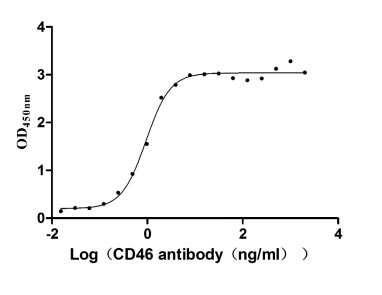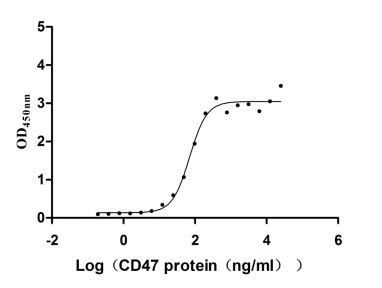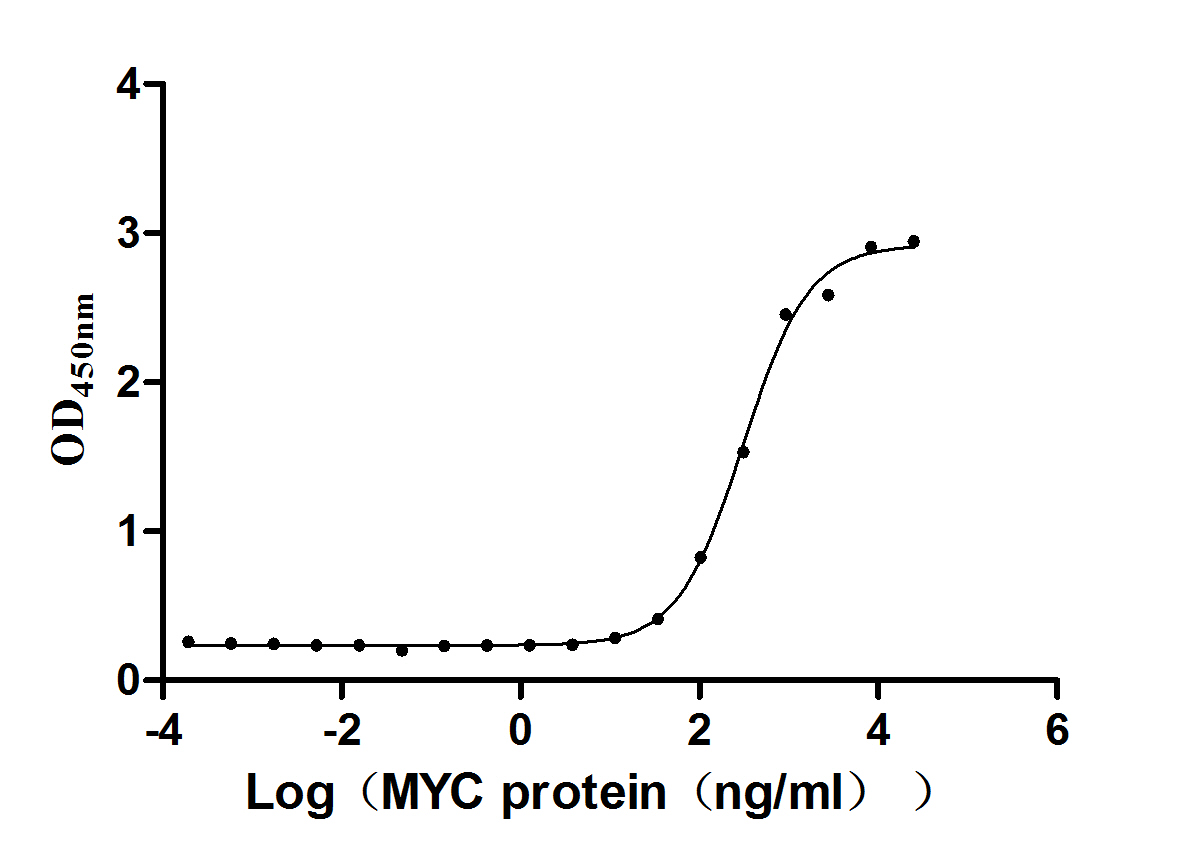Recombinant Mouse Nuclear factor interleukin-3-regulated protein (Nfil3)
-
货号:CSB-YP015757MO
-
规格:
-
来源:Yeast
-
其他:
-
货号:CSB-EP015757MO-B
-
规格:
-
来源:E.coli
-
共轭:Avi-tag Biotinylated
E. coli biotin ligase (BirA) is highly specific in covalently attaching biotin to the 15 amino acid AviTag peptide. This recombinant protein was biotinylated in vivo by AviTag-BirA technology, which method is BriA catalyzes amide linkage between the biotin and the specific lysine of the AviTag.
-
其他:
-
货号:CSB-BP015757MO
-
规格:
-
来源:Baculovirus
-
其他:
-
货号:CSB-MP015757MO
-
规格:
-
来源:Mammalian cell
-
其他:
产品详情
-
纯度:>85% (SDS-PAGE)
-
基因名:Nfil3
-
Uniprot No.:
-
别名:Nfil3; E4bp4; Nuclear factor interleukin-3-regulated protein; E4 promoter-binding protein 4; Embryo implantation-related NFIL3/E4BP4-like transcription factor
-
种属:Mus musculus (Mouse)
-
蛋白长度:Full length protein
-
表达区域:1-462
-
氨基酸序列MQLRKMQTIK KEPAPLDPTS SSDKMLLLNS ALAEVAEDLA SGEDLLLNEG SMGKNKSSAC RRKREFIPDE KKDAMYWEKR RKNNEAAKRS REKRRLNDLV LENKLIALGE ENATLKAELL SLKLKFGLIS STAYAQEIQK LSNSTAVYFQ DYQTSKAAVS SFVDEHEPAM VAGSCISVIK HSPQSSLSDV SEVSSVEHTQ ESPAQGGCRS PENKFPVIKQ EPVELESFAR EAREERGTYS TSIYQSYMGS SFSTYSHSPP LLQVHGSTSN SPRTSEADEG VVGKSSDGED EQQVPKGPIH SPVELQRVHA TVVKVPEVNP SALPHKLRIK AKAMQVKVEA LDSEFEGMQK LSSPADAIAK RHFDLEKHGT SGMAHSSLPP FSVQVTNIQD WSLKSEHWHH KELSSKTQSS FKTGVVEVKD GGYKVSEAEN LYLKQGIANL SAEVVSLKRF IATQPISASD SR
-
蛋白标签:Tag type will be determined during the manufacturing process.
The tag type will be determined during production process. If you have specified tag type, please tell us and we will develop the specified tag preferentially. -
产品提供形式:Lyophilized powder
Note: We will preferentially ship the format that we have in stock, however, if you have any special requirement for the format, please remark your requirement when placing the order, we will prepare according to your demand. -
复溶:We recommend that this vial be briefly centrifuged prior to opening to bring the contents to the bottom. Please reconstitute protein in deionized sterile water to a concentration of 0.1-1.0 mg/mL.We recommend to add 5-50% of glycerol (final concentration) and aliquot for long-term storage at -20℃/-80℃. Our default final concentration of glycerol is 50%. Customers could use it as reference.
-
储存条件:Store at -20°C/-80°C upon receipt, aliquoting is necessary for mutiple use. Avoid repeated freeze-thaw cycles.
-
保质期:The shelf life is related to many factors, storage state, buffer ingredients, storage temperature and the stability of the protein itself.
Generally, the shelf life of liquid form is 6 months at -20°C/-80°C. The shelf life of lyophilized form is 12 months at -20°C/-80°C. -
货期:Delivery time may differ from different purchasing way or location, please kindly consult your local distributors for specific delivery time.Note: All of our proteins are default shipped with normal blue ice packs, if you request to ship with dry ice, please communicate with us in advance and extra fees will be charged.
-
注意事项:Repeated freezing and thawing is not recommended. Store working aliquots at 4°C for up to one week.
-
Datasheet :Please contact us to get it.
相关产品
靶点详情
-
功能:Acts as a transcriptional regulator that recognizes and binds to the sequence 5'-[GA]TTA[CT]GTAA[CT]-3', a sequence present in many cellular and viral promoters. Represses transcription from promoters with activating transcription factor (ATF) sites. Represses promoter activity in osteoblasts. Represses transcriptional activity of PER1. Represses transcriptional activity of PER2 via the B-site on the promoter. Activates transcription from the interleukin-3 promoter in T-cells. Competes for the same consensus-binding site with PAR DNA-binding factors (DBP, HLF and TEF). Component of the circadian clock that acts as a negative regulator for the circadian expression of PER2 oscillation in the cell-autonomous core clock. Protects pro-B cells from programmed cell death. Represses the transcription of CYP2A5. Positively regulates the expression and activity of CES2 by antagonizing the repressive action of NR1D1 on CES2. Required for the development of natural killer cell precursors.
-
基因功能参考文献:
- These findings provide mechanistic insight into how the intestinal microbiota regulates body composition and establish NFIL3 as an essential molecular link among the microbiota, the circadian clock, and host metabolism. PMID: 28860383
- E4BP4 acts as a key pro-adipogenic transcription factor by trans-repressing COX2 in glucocorticoid-associated adipocyte differentiation. PMID: 28416324
- NFIL3 functions as an important regulator of glucose homeostasis in the liver by limiting CREB-mediated hepatic gluconeogenesis. PMID: 29132537
- We identified PD-1 to be specifically expressed in PLZF(+) ILCp and revealed that the timing and order of expression of the transcription factors NFIL3, ID2, and TCF-1 was critical. Importantly, induction of ILC lineage commitment required only transient expression of NFIL3 prior to ID2 and TCF-1 expression. PMID: 27705792
- Uterine lumen closure, early embryonic development, and differentiation of antimesometrial decidua were delayed in Nfil3(-/-) implantation sites. Major disturbances to the decidual-trophoblast interface that did not lead to fetal death were attributed to NFIL3 deficiency in trophoblast. PMID: 26985000
- In hepatocytes, E4BP4 interacts with nuclear SREBP-1c to preserve its acetylation, and subsequently protects it from ubiquitination-dependent degradation PMID: 27252523
- study found that approximately one quarter of the submandibular salivary gland (SMG) NK cells develop independently of NFIL3; data show that the SMG tissue environment shapes a unique repertoire of NK-like cells with distinct phenotypes PMID: 27521341
- New direct Wnt/beta-catenin target gene Nfil3 , which induced epithelial-mesenchymal transition, cell migration and experimental metastasis of Colorectal cancer cells was identified. PMID: 26156959
- removal of NFIL3 in vivo does not recapitulate the regeneration-promoting effects that were previously observed in vitro. PMID: 25993115
- These findings establish that NFIL3 directs the differentiation of a committed innate lymphoid cell precursor. PMID: 25310240
- establish NFIL3 as a key regulator of common helper-like innate lymphoid cells progenitors as they emerge during early lymphopoiesis PMID: 25801035
- Iso-mediated induction of Nfil3 in osteoblasts regulates the expression of Ptgs2 by driving the expression of circadian clock genes PMID: 24994935
- E4BP4 plays a crucial role in glucocorticoid -evoked apoptosis of osteoblasts by enabling induction of Bim PMID: 24658772
- Nfil3 is a key regulator of the development of innate lymphoid cell subsets essential for immune protection in the lung and gut. PMID: 25092873
- Nfil3 is critical for normal development of gut-associated type 3 innate lymphoid cells. Nfil3 deficiency severely compromises intestinal innate immune defense against acute bacterial infection with Citrobacter rodentium and Clostridium difficile. PMID: 25113970
- signals transmitted by Ly49H and proinflammatory cytokines are sufficient to promote NK cell differentiation in the absence of Nfil3. PMID: 24740507
- E4bp4 is required for commitment to the natural killer (NK) lineage and promotes NK development by directly regulating the expression of the downstream transcription factors Eomes and Id2. PMID: 24663216
- Data indicate E4BP4-independent NK cell developmental pathways and a role for E4BP4 in NK cell homeostasis. PMID: 24534532
- Findings indicate that the transcription factor Nfil3 (E4bp4) drives the formation of mature NK cells by inducing Eomes expression and reveal the differential requirements of NK cell subsets for Nfil3. PMID: 24532575
- NFIL3 is a microbiota-dependent, IL-10-independent regulator of mucosal homeostasis via IL-12p40. PMID: 24442434
- NFIL3 plays a neuroprotective role in neurons and constitutes a potential therapeutic target for neurodegeneration. PMID: 24280221
- expression of Nfil3 is crucial only early in the development of NK cells PMID: 24277151
- the transcription factor NFIL3 suppresses T(H)17 cell development by directly binding and repressing the Rorgammat promoter. PMID: 24202171
- a functional liver clock is required for the proper nutritional and circadian regulation of USP2-45 expression; at the molecular level, transcriptional coactivators PGC-1alpha and PGC-1beta and repressor E4BP4 exert opposing effects on USP2-45 promoter activity PMID: 23133608
- NFIL3 is required for normal glucocorticoid-induced cell death in CTLL-2 T cells, and is localized in thymocytes undergoing apoptosis. PMID: 23425966
- A previously undescribed pathway by which CD8alpha+ Dendritic cells emerge independent of Id2, Nfil3, and Batf3, but dependent on Irf8. PMID: 23297132
- G9a mediates E4BP4-dependent suppression of hepatic Fgf21 by enhancing histone methylation (H3K9me2) of the Fgf21 promoter PMID: 23283977
- PTHrP(1-34)-mediated repression of the PHEX gene in osteoblastic cells involves the transcriptional repressor E4BP4. PMID: 21826652
- NFIL3 plays an essential role in the development of CD8alpha(+) cDCs. PMID: 21474667
- Taken together, these data indicate that NFIL3 is a key regulator of T(H)2 cytokine expression. PMID: 21499227
- E4BP4 has multiple functions in controlling the plasticity of IL-13 in Th1 cells and IL-10 in Th1 cells, Th2 cells, T(reg) cells, and NKT cells. PMID: 21460847
- NFIL3-deficient B cells fail to produce IgE in response to LPS plus IL-4. These defects may be due to the reduced production of immunoglobulin heavy chain germline epsilon transcripts in the absence of NFIL3. PMID: 20697558
- NFIL3 has a key regulator of IL-4-induced B cell stimulat4ion and IGE class switching. PMID: 20080759
- the GATA factors play an important role in transducing the survival signal of IL-3, and one of their cellular targets is E4bp4 PMID: 12023274
- Results indicated that E4BP4 may play a critical role in embryo implantation process by promoting stromal cell proliferation and inhibiting decidual cell apoptosis. PMID: 16944583
- E4BP4 functions as a repressor of Per2 transcription through a novel E4BP4-binding site in the promoter. PMID: 17182630
- E4BP4 interacts with PER2, which represses transcriptional activity via the E-box enhancer. Interaction with PER2 required the carboxyl-terminal region that contains the repression domain of E4BP4. PMID: 17274955
- E4BP4 is a negative transcription factor for circadian Mdr2 mRNA expression PMID: 18242748
- Identification of adjacent binding sites for the YY1 and E4BP4 transcription factors in the PrP (Prion) gene promoter. PMID: 19129193
- requirement of Nfil3 for the development of cells of the NK lineage. PMID: 19995955
显示更多
收起更多
-
亚细胞定位:Nucleus.
-
蛋白家族:BZIP family, NFIL3 subfamily
-
组织特异性:Expressed in suprachiasmatic nucleus and liver (at protein level). Expressed in suprachiasmatic nucleus, hippocampus, gyrus dentatus, piriform cortex, internal granular layer of olfactory bulb, dorsomedial hypothalamic nucleus, pontine nuclei, granular la
-
数据库链接:
KEGG: mmu:18030
STRING: 10090.ENSMUSP00000065363
UniGene: Mm.136604
Most popular with customers
-
Recombinant Human Membrane cofactor protein (CD46), partial (Active)
Express system: Mammalian cell
Species: Homo sapiens (Human)
-
Express system: Mammalian cell
Species: Homo sapiens (Human)
-
Recombinant Human Heat-stable enterotoxin receptor (GUCY2C), partial (Active)
Express system: Mammalian cell
Species: Homo sapiens (Human)
-
Recombinant Human papillomavirus type 16 Protein E7 (E7) (Active)
Express system: E.coli
Species: Human papillomavirus type 16
-
Recombinant Human Nectin-4 (NECTIN4), partial (Active)
Express system: Mammalian cell
Species: Homo sapiens (Human)
-
Recombinant Human Claudin-18.2 (CLDN18.2)-VLPs (Active)
Express system: Mammalian cell
Species: Homo sapiens (Human)
-
Recombinant Human Complement component C1q receptor (CD93), partial (Active)
Express system: Mammalian cell
Species: Homo sapiens (Human)
-
Recombinant Human Lymphocyte antigen 6 complex locus protein G6d (LY6G6D) (Active)
Express system: Yeast
Species: Homo sapiens (Human)







-AC1.jpg)












